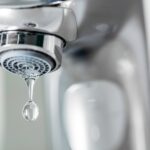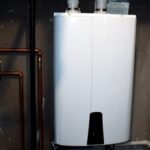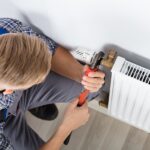Air vent – A small valve, which enables air that has accumulated at the top of a radiator to be let out or ‘bled’ from the radiator using a special air vent key. Also known as a bleed valve or bleed vent.
Angled valves – Valves that have a 90 turn on them for use on radiators with side valve connections, where pipe work is coming up from the floor or out of the wall. Also used on radiators with underside valve connections, but only where the pipe work comes out of the wall. See also “Straight valves.”
Balancing – Adjusting the flow of water throughout a piped central heating system in order to achieve a similar drop in temperatures across all radiators. It is important to ensure that heat is distributed evenly to all radiators so that they all run at equal temperatures and all take an equal amount of time to reach their operating temperature. A plumber should ‘balance’ the system after installing radiators. Lack of balancing within a system is often the cause of cold spots on radiators, radiators failing to heat up properly or noisy radiators.
BBOE – Bottom Bottom Opposite Ends – Radiator valves are installed at the bottom of the radiator, on either side.
Bleeding a radiator – Getting rid of any air that has accumulated at the top of radiator, using an air vent or bleed valve. Trapped air in a radiator will result in a radiator failing to heat up properly.
Bleed valve – see “Air vent”
Bleed vent – see “Air vent”
Boiler – a device that heats water using gas, oil or electricity. This is the most common way to provide hot water central heating for domestic properties.
Bracket – a part used to secure/fix radiators to the wall
British Thermal Unit – (BTU or Btu) is a traditional unit of energy equal to about 1,055 joules. It is approximately the amount of energy needed to heat 1 pound (0.454 kg) of water (therefore around 0.1198 gallons) from 39 to 40 F (3.8 to 4.4 C). This unit of measurement is now being replaced with the alternative unit of measuring heat output, Watts.
BS 3528 – The old British standard for radiators. BS EN 442 has now superseded this.
BS 5449: 1990 – The British Standard for internal room temperatures, identifying acceptable comfort levels.
BS 7593: 2006 – The British Standard for the treatment of water in domestic hot water central heating systems, including the use of corrosion inhibitors and cleaners.
BS EN 12828 & 12831: 2003 – British Standards for designing heating systems.
BS EN 442 – The official European Standard for radiators. It covers various standards that radiators need to meet including heat output, minimum material thickness, pressure tests, paint quality, product labelling, safety, etc.
BTU – See “British Thermal Unit”
Bush – see “Reducer”
Central Heating – A system that provides warmth to the whole interior of a building (or portion of a building) from one point to multiple rooms.
Closed System – A piped central heating system that is “closed” or “sealed” means that the water contained within the system is taken from the water mains upon installation. Once filled and pressurised the system is sealed off and then the water within the system is circulated repeatedly around the system and is not (unless actioned via the filling loop) replaced by new water entering the system.
Combi boiler – a device that provides both central heating and hot water. A combi boiler is a high-efficiency water heater and a central heating boiler, combined (hence the name) within one compact unit. Therefore, no separate hot water cylinder is required, offering space saving within a property. “Combis” are a very popular choice for domestic properties.
Combination boiler – see “Combi boiler”
Convector – a device that is designed to “convect” heat, using the physics of warm air rising and cold air falling to create a natural cycle of air circulating around a room. Radiators convect heat as well as radiating heat.
Corrosion inhibitor – a chemical that installers add to the water in standard piped central heating systems to prevent internal corrosion of non-inert metals as per BS 7593: 2006. Examples of corrosion inhibitors include Fernox MB-1 and Sentinel X100.
Direct System – Cold water is taken from the mains and goes directly to points of delivery (taps) around a property where cold water is required.
Dt – Also written as Dt or Delta t. “BTUs” or “Watts” are a measure of how good a radiator is at heating a room at standard temperature; the Dt value defines what that standard temperature is. Naturally the hotter a radiator is, the more heat it gives out. Since water cools on its passage through a radiator, the temperature of the water entering it is higher than the temperature of the water leaving it. The mean value of the inlet (flow) and outlet (return) temperatures is taken and the approximate room temperature is subtracted from this figure, universally quoted as 20C. The difference, known as Dt, is the operating temperature that is given in the radiator’s specifications.
Dt of 50C – Delta t 50: The European standard for the operating temperature of central heating systems, which determines the heat outputs achievable from radiators.
Dt of 60C – Delta t 60: The British standard for the operating temperature of central heating systems, which determines the heat outputs achievable from radiators.
Duel Fuel – A radiator that is connected to the central heating system, but also has an electric element for use in the warmer months when the central heating isn’t turned on. A popular choice for bathroom radiators.
Economy 7 – An electricity tariff, where you pay a different price for your electricity at different times of day, so the electricity you use at night costs less than the electricity you use during the day – a bit like peak and off-peak phone calls. It’s called “Economy 7” because you get cheaper electricity for 7 hours each night. Some appliances, like storage heaters, are designed to take advantage of the cheaper electricity available during the night.
End bush – see “Reducer”
Expansion tank – The tank at the top of on open system, which allows the expanding hot water from the cylinder to spill out and be stored.
Expansion vessel – A small tank used in closed water heating systems and domestic hot water systems to absorb excess water pressure, which can be caused by thermal expansion as water is heated. The vessel itself is a small container divided in two by a rubber diaphragm. One side is connected to the pipe work of the heating system and therefore contains water. The other, the dry side, contains air under pressure. This is not the same as an expansion tank.
Flow – In central heating terms, this refers to the water coming from the boiler and also the point at which water enters radiators. See also “Return.”
Heat calculations – These are performed in order to work out the heat output requirement of a room. The calculations are based on numerous factors, but are primarily based on the volume and type of room. The actual size of the radiator required to achieve the required heat output can also be affected by other factors: see “Dt” and “Mean Water Temperature.”
Heat output – the amount of heat that is emitted from a heat source. The heat output can be measured in units of Watts or British Thermal Units.
Indirect System – Cold water is taken from the mains and enters the property. It has one draw off point (generally the kitchen sink) as well as pipework that feeds the cold water tank. The stored water in the tank feeds all other cold water points in the property.
Inert metals – Do not corrode when in contact with oxygenated water. Examples include stainless steel, copper and brass. Non-inert metals include mild steel, cast iron and aluminium and are used on central heating systems in conjunction with corrosion inhibiting chemicals as per BS 7593: 2006.
Joining nipple – a metal collar with opposing threads at each end, which acts like an internal nut and is used for joining radiator sections together.
Lockshield – A valve that is used to restrict the flow of water on the return side of a radiator in order to “balance” the radiator on the system. Valves usually come as a pair and the “lockshield” valve is supplied along with either a “thermostatic” or “manual” control valve. See also “Return” and “Balancing.”
Manual radiator valve – Act simply like taps as they directly control the flow of water into a radiator and consequently how hot the radiator gets, regardless of the surrounding room temperature. Manual valves have no labelled settings – you simply turn the valve head until the radiator is giving the amount of heat desired.
Mean water temperature (MWT) – The mean temperature of the water in a central heating system. For example; a system operating at 90-70-20C will have a mean water temperature of 80C
Microbore(piping) – pipe that is only 10mm and 8mm in diameter that is narrower than the standard 15mm copper pipe or traditional 22mm pipe.
Nipple – See “Joining nipple”
Open System – an un-pressurized central heating system. Water is drawn into the system from the mains when required via the expansion tank. As water heats up and “expands” in the system, the excess water is released as necessary back into the expansion tank, which is usually, but not always found high up within a property. Also known as an open-vented system.
Pipe centre measurement – the measurement from the centre of one pipe to the centre of another pipe and the measurement from the wall to the centre of the pipe. This measurement is useful for the installation of pipework for a radiator; especially where pipework is to be installed before the radiator is present.
Pressurized system – see “Closed System”
Radiator – a device that is designed to “radiate” heat, to force heat outwards. In reality, most radiators also convect heat to some degree, for example most standard corrugate steel panel radiators radiate 85% of their heat and convect 15% of their heat.
Radiator valve – see “Valve”
Reducer – a part that is designed to reduce the size of a connection, often used on radiators. Also known as an “end bush” or “bush.”
Return – This refers to either the water going back to the boiler or the point on a radiator where the water exits. See also “Flow.”
Sealed system – see “Closed System”
Secondary Hot Water System – a piped central heating system where the water that runs through the system is the same water that comes out of your taps. As a consequence, the water needs to be clean and free from chemicals, so radiators and parts on this system need to be made of inert metals such as copper, brass or stainless steel. Parts made of mild steel, aluminium and cast iron, which need to be used in conjunction with corrosion inhibitor, are not suitable.
Straight valves – Valves that are straight for use on radiators with underside connections where the pipes are coming out of the floor.
Tap – A valve controlling release of liquids or gas. The word ‘tap’ is sometimes used as an alternative to ‘valve’.
Tapping centre measurement – The distance between the valve connection points on a radiator.
TBOE – Top Bottom Opposite Ends – Radiator valves are installed at the top on one side of the radiator, and the bottom of the other side of the radiator.
TBSE – Top Bottom Same Ends – Radiator valves are installed at the top and bottom on the same end of the radiator.
Thermostatic Radiator Valve (TRVs) – Include an in-built temperature sensor. A thermostatic valve will maintain a space at the temperature selected, by automatically adjusting the heat output from the radiator. As a thermostatic valve is controlled automatically, it turns itself up and down, ensuring the radiators perform as efficiently as possible, reducing energy waste. For this reason, TRVs are the environmentally friendly valve choice as they prevent energy wastage.
Towel radiator – A radiator that is designed specifically to warm towels as well as a room, often used in bathrooms or kitchens.
Towel rail – Historically this phrase just meant a rail for hanging towels, but over recent years this phrase has come to mean a radiator that has been designed to keep towels warm and dry. It is now used in both instances. Other terms used included heated towel rail and towel radiator.
TRV – See “Thermostatic Radiator Valve”
Un-pressurized system- see “Open System”
Valve – A device that regulates, directs or controls the flow of a fluid by opening, closing, or partially obstructing various passageways. In radiators and central heating systems, valves are used to control water flowing around a system and particularly in and out of radiators.
Wall tie – a device used to attach a radiator or similar to a wall. Sometimes called a wall stay.
Watts – A derived unit of power in the International System of Units (SI), named after the Scottish engineer James Watt (1736-1819). The unit, defined as one joule per second, measures the rate of energy conversion. In heating, watts are used to measure the heat output given by a heat source such as a radiator.
75-65-20C operating temperature- Water on a hot water piped system will leave the boiler at 75C and return to the boiler at 65C losing a nominal 20C across the whole system. See also Dt 50C
90-70-20C operating temperature- Water on a hot water piped system will leave the boiler at 90C and return to the boiler at 70C losing a nominal 20C across the whole system. See also Dt 60C
If you can’t find the information you need above or need help with choosing a radiator, then contact a specialist.
Dublin’s Reliable Plumbing, Heating & Gas Experts: Trusted Over 20 Years
Get FAST service and EXPERT solutions for all your Heating and Plumbing needs in Dublin and call on the trusted experts at Kildare Plumbing & Heating.
1. SAME DAY EMERGENCY REPAIRS – 24/7 SERVICE
Whether your water heater has broken down or your heating isn’t working, you can depend on Kildare Plumbing & Heating to have you cosy again or enjoying a hot shower FAST, TODAY, 24/7!
2. 12 MONTH LABOUR GUARANTEE
Enjoy the peace of mind that comes with our 12month labour guarantee.
3. FAST SERVICE WHEN YOU NEED IT
We have experts positioned across Dublin, so when you call, we will dispatch the nearest available to ensure the speediest response.
4. UP-FRONT PRICES
You’ll appreciate the convenience of knowing the cost of our services before proceeding, as we charge by the job and not an hourly rate.
5. ALL YOUR DRAIN REPAIRS AND UNBLOCKING SOLUTIONS
If you have a drain issue, we can help. With expert solutions for all your drain issues, including blockage removal, excavations and CCTV drain surveys.
6. ALL PLUMBING SERVICES
From no hot water to leak repairs to bathroom refurbishments, whatever your plumbing service need, we have the solution and expertise to help.
7. THE EXPERTS FOR YOUR HEATING REPAIRS & INSTALLATIONS
Keep your home warm and cosy and call on Kildare Plumbing & Heating for your heating system repairs, service and new installations.
8. TRUSTED FOR OVER 20 YEARS
We’ve been the trusted choice for over 20 years and our team are dedicated to providing you with the best customer service – satisfaction guaranteed.
For great service and expert solutions for your plumbing, drain and heating services across Dublin, choose the 24/7 rapid response professionals and call on Kildare Plumbing & Heating today.




